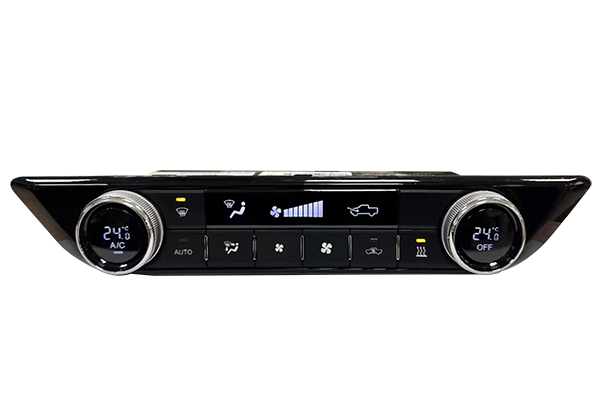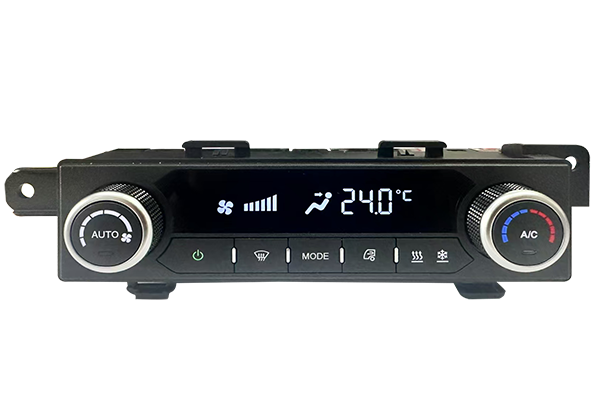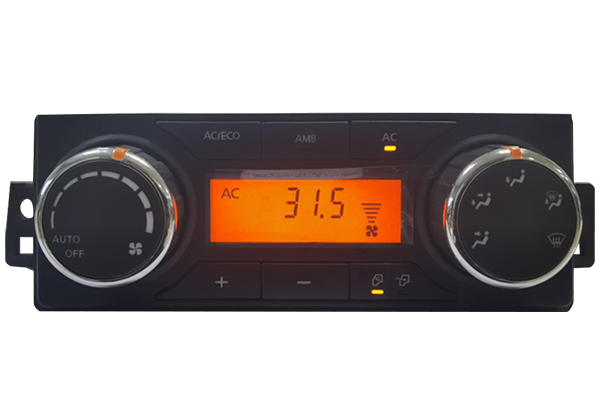
2025-08-21
The car air conditioning controller is an essential component to adjust the driving environment. From the previous simple manual air conditioning to the current automatic air conditioning, the LCD as an essential human-computer interaction medium makes the operation more simple and friendly.
In the early 2000s, with the significant reduction of hardware and development costs, TFT color liquid crystal displays were rapidly popularized in the automotive instrument industry. With the rise of central control entertainment and navigation in automobiles, automotive air conditioning controllers were gradually integrated into the central control system.
However, due to the increasingly complex control and operation interfaces of automotive air conditioning systems integrated into central control systems, coupled with growing consumer complaints, this solution has gradually been abandoned by OEMs.The LCD segment display air conditioning controller solution has regained prominence in the developer community, particularly with the widespread adoption of rear-seat cabin air conditioning controllers. Recognized for its cost-effective LCD technology and short development cycles, this display solution has become a preferred choice among automotive manufacturers.

I. Market size and growth drivers
1. Overall market space
The global automotive air conditioning controller market is expected to reach $4.9 billion in 2032, with a compound annual growth rate of 5.0%, among which the penetration rate of digital control panels continues to increase.
As the core of growth, China’s automobile air conditioning LCD segment display capacity will exceed 20 million sets in 2030, accounting for 40% of the global proportion. The demand is mainly from new energy vehicles (penetration rate over 30%) and intelligent cockpit upgrades.
2. Subdivisional requirements of LCD segment display
LCD segment displays account for 35-40% of the market in low-cost models and basic functional controllers, mainly due to their cost advantages (less than 1/3 of the unit price of color TFT-LCD) and Low power LCD (standby power consumption is only 0.5μA).
Application scenarios are concentrated in manual/semi-automatic air conditioning controllers (accounting for 70% of low-end models).
II. Demand drivers
1. Cost and reliability requirements
The BOM cost of LCD segment display is more than 50% lower than that of TFT. The automotive-grade wide temperature type LCD supports (-40℃~85℃) and anti-vibration design (IP65 protection) meet the automotive-grade reliability standards.
2. Incremental demand for new energy vehicles
Electric vehicles need to independently control the battery cabin and passenger cabin air conditioning, drive the multi-region temperature control system popularization, LCD segment display because of low power consumption (<100nA) become the first choice for auxiliary control panel.
In 2024, LCD segment display penetration rate in air conditioning secondary control panel will reach 65% for electric models.
3. Policy and standardization drive
The mandatory energy efficiency labeling of new energy vehicles in the European Union and China shows that monochrome screens have become the core component of energy efficiency indicator modules for instruments due to their long life (> 100,000 hours).
III. Technology Trends and Innovation
Integrated programmes
Display driver + cover automotive air conditioning controller solution for Eastern Display:
Integrated LCD drive and control.
Fully fitted cover plate, integrated cover plate and touch function, and achieve a unified black display effect.
Multi-color and color gradient screen printing comparable to TFT display effect.
2、 innovation scheme
The Eastern Display’s full view VALCD solution enables 360-degree full view display.
IV. Challenges and Substitution Risks
1. Pressure of technological substitution
The price of full-color TFT-LCD drops by 8% annually, and it gradually penetrates into the models below 100,000, squeezing the space of monochrome screen in the middle market.
2. Inadequate supply chain resilience
The import dependence of vehicle-grade driver IC is over 90%, and trade and geopolitical conflicts may lead to the risk of supply interruption (such as the impact of increased global tariffs in the United States).

Summary and outlook
Short-term opportunities (2025-2027):
Seize the upgrade window of new energy vehicle secondary control panels (such as rear temperature control, battery status display) and basic air conditioning system for commercial vehicles, and focus on integrated drive solutions.
Long-term Strategy (2028-2030):
LCD segment displays remain the golden balance point of “cost-effectiveness + reliability” in automotive air conditioning controllers, but they must address dual challenges of TFT screen penetration and supply chain localization. Enterprises should strengthen integrated design capabilities with supporting manufacturers to provide OEMs with one-stop control panel solutions.
As a leading LCD manufacturer in mainland China, Eastern Display has been dedicated to the development, design, and production of automotive LCDs since the 1990s. Since the early 21st century, the company has provided high-quality LCD products, particularly VALCD series, to automotive air conditioning controller manufacturers. These solutions meet the stringent requirements for wide temperature tolerance, high contrast ratio, and broad viewing angles in automotive LCD applications. Currently supplying over 10 million units to domestic and international clients including FAW, Dongfeng, Yutong, Chery, Leapmotor, Li Auto, Kia, Sany Heavy Industry, and Zoomlion, Eastern Display has earned widespread recognition in industries such as automotive air conditioning systems and automotive instrument clusters.
